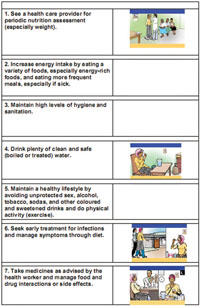12.3.1 Nutritional care of HIV-positive adults and adolescents
Your work in the community will almost certainly bring you into contact with people living with HIV. This gives you the opportunity to help them maintain their health for as long as possible. For this reason you should make sure that they are weighed on a regular basis. You may have to speak to them in detail about the need for them to attend for weighing on a regular basis; you can explain that it will enable you to monitor their health and provide them with good advice.
Why do you think it is important for people living with HIV to be weighed periodically?
It is important to weigh people regularly because weight loss is a sign of disease progression. If you see that a person is losing weight, you can suggest ways of increasing their nutrition intake so they do not have nutrition deficiencies which can lead to a weak immune system.
Look carefully at the series of pictures in Figure 12.3. These show seven ways that you could recommend to PLHIV how to maintain their strength.

In addition to these seven activities, people living with HIV might require micronutrient supplementation. Sometimes the use of traditional therapies to boost nutrition and maintain strength is also really important.
How would you encourage PLHIV to adopt these seven activities?
You could talk to them about the importance of eating enough healthy food to ensure their immune system stays as strong as possible, so they are not vulnerable to infection and can try to slow the progression to AIDS.
What diet would you recommend to someone in your community who is living with HIV?
The best and recommended source of good nutrition is a variety of foods, including fruits and vegetables, grains, and animal products.
12.3 Nutritional care of people living with HIV
